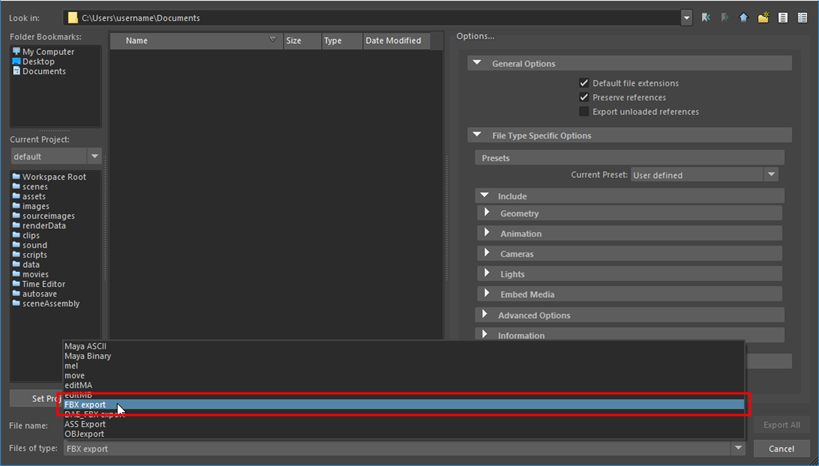

For exporting, set units to meters in the FBX export settings. Before you start to create assets, we recommend that you set your scene units in Maya to meters. As shown in the image, each of these objects was given its own appropriate name.Īzure Remote Rendering uses meters for measurement and the up direction is the Y-axis. Each object represents a different type of material.
#Maya export fbx how to
Here's how to set up a PBR material in Maya.Īs you'll see in the sample scene, we've created a number of box objects.
#Maya export fbx full
It's a grayscale map that indicates which areas of a model receive full lighting (white) or full shade (black). Ambient Occlusion, which is used to add soft shading and contact shadows to a model.Examples of detail might be pitting and dents on a metal surface or grain in wood. Normal, which adds detail to a surface without having to add more polygons.Roughness, which determines how rough or smooth a surface is and affects the sharpness or blurriness of the reflections and highlights on a surface.Metalness, which determines if a material is metallic and which parts are metallic.Albedo, which is the materials color map and is also called Diffuse or BaseColor.Broadly speaking, each material contains all or most of the following textures: They're assigned different materials, such as wood, metal, painted metal, plastic, and rubber. The sample scene in this tutorial contains a number of polygon box objects. This tutorial is a guide to basic PBR shader setup and FBX export for Azure Remote Rendering projects. It's similar in many ways to PBR setup in other content-creation apps like 3DS Max. Export a scene to FBX format, and select important options.Ĭreating physically based rendering (PBR) materials in Maya is a relatively straightforward task.Handle instancing of objects and materials.Assign materials with advanced lighting to objects in the scene.If you have any questions or, please contact us. Any errors and warnings, such as issues with texture formats, will be logged in the Script Editor ( Window → General Editors → Script Editor), as well as a log file in your Maya preferences directory. When the upload is complete, you can view your model on Sketchfab, adjust rendering settings, and save the default view. If successful, the model's URL will appear.Enter a title, description, tags, and mark it as.If this is your first time running the exporter, go to Settings → Sketchfab Settings, enter your API token and any default tags (stored for future use), then Save.Click the script icon to open the Sketchfab Uploader window.Under FBX File Format, you can also change Type to Binary, which will reduce file sizes and upload times. In the options, make sure Embed Media is enabled. and choose FBX export from the Files of type drop-down. In order to preserve texture information, it's important to check your FBX export settings. It will be in the list as fbxmaya.bundle (Mac OS X) or fbxmaya.mll (Windows). You can check that the plug-in is loaded from Window → Settings/Preferences → Plug-in Manager. If it's not, you can find instructions for installing it in the Autodesk Knowledge Base. The FBX plug-in comes with Maya and should be automatically installed and loaded. The exporter should then be available in the Custom shelf in Maya. This will move script files into your Autodesk plugin path.Linux: extract the SH file to your home directory and execute it via a terminal console window.
#Maya export fbx download


 0 kommentar(er)
0 kommentar(er)
